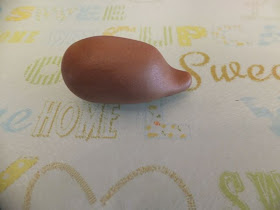No wonder there are entire blogs just dedicated to pursuing the perfection of these things.
So, needless to say I've been " macarooning" again...
My husband took our children off to the farm for the afternoon and evening.
The first thing I did was get a pedicure. Haven't had one of those in over 4 years! How have I been coping?!
I came home to a very quiet house. Very. And didn't really know what to do with myself. So I landed up in the kitchen, of course!
I've had some egg whites aging in the fridge for a few days now. Just waiting for an opportunity like today: this was the first time I've made Macarons with NO interruptions. It should be part of the list of requirements in the recipe! It obviously helps.
Really, it does: Macarons are all about ingredients, technique and timing. Okay, all baking is ; )
But it is especially so with these tricky treats.
You can't let your whipped meringue sit for too long before mixing in the almonds/ icing sugar. And then, while folding it into the meringue, don't get distracted and over-mix it! Then, you can't let the mixed batter sit for too long before piping it out. And don't over-handle the piping bag, either...
I think you've probably just got to accept that your first few (dozen!) batches will be failures. I hope they aren't, but if they are - don't be discouraged. It's a learning curve. Take heart, as long as you are learning : )
So look at the results and try figure out what needs to change for the next batch. Here are 2 links to troubleshooting tips that I found helpful: www.misohungry.blogspot.com/2011/01/troubleshooting-macaron.html and www.notsohumblepie.blogspot.com/2010/08/macaron-troubleshooting-new-recipe.html
Here is the recipe that is working for me. ("Macaron Confusion").
Once you've made them a few times you get the feel for the batter, and can recognize the "ribbon" stage when it's sufficiently mixed and ready for piping.
Another factor is oven temperature - if I'd known how important that variable was, I might not have attempted Macarons with my dodgy, dodgy oven (the one that blasts out 240'C heat when dialed to 180'C). And oven temp. is what I've concentrated on the last couple of batches.
I now place the Macarons into an oven that has been pre-heated to 175'C, immediately turn it down to 150'C, then after about 10 minutes crack open the door; and then leaving it slightly open, check on the mac's every 30-60sec thereafter. That's how quickly they can brown!
And just before the browning starts, take them out the oven. (Undercooked macaron shells will crack and collapse.)
Nothing complicated ; )
Now that those are out if they way, I can't wait for my little distractions to come home tomorrow. Children really help you appreciate things in life - even if somedays it's just the quiet and calm once they've gone to bed!
Happy baking!
xxM




















































